Do I Have Bad Posture?
If you are 20 years or older, you probably have bad posture.
Just like diabetes, you may never know until you begin to develop symptoms.
After reading this post, you will be able to determine how bad your posture is.
Let’s get started.
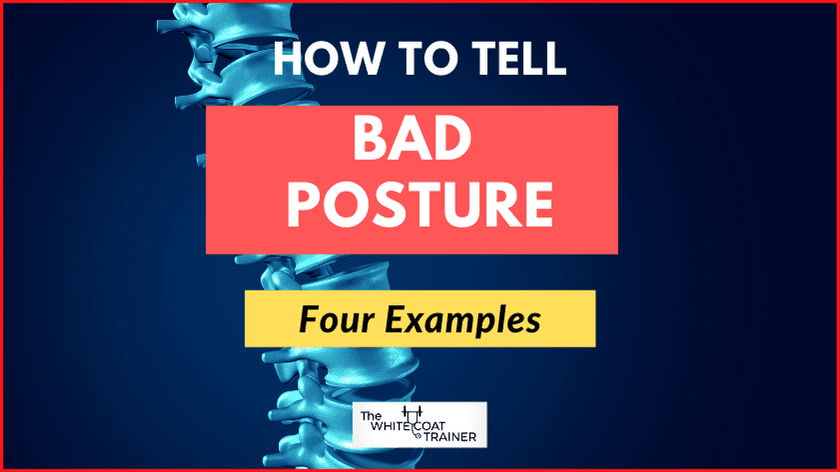
How To Have Good Posture When Standing
First, let’s define what good posture is. Good posture is when all of your joints are in proper alignment anatomically.
Here is what proper posture looks like while standing.

Proper Standing Posture CheckList
When standing up, you must ensure that
- Head is in a neutral position and the ear is lined up with the middle of the shoulder joint
- The middle of the shoulder joint is in line with the ear
- The upper and lower back are in a neutral position with a natural kyphotic and lordotic curve (slight curves are normal)
- The middle of the hip is in line with the middle of the shoulder above and the middle of knee joint below
- Middle of the knee is in line with the middle of the ankle
How To Have Good Posture When Sitting
Proper sitting posture looks almost exactly the same as a standing posture.
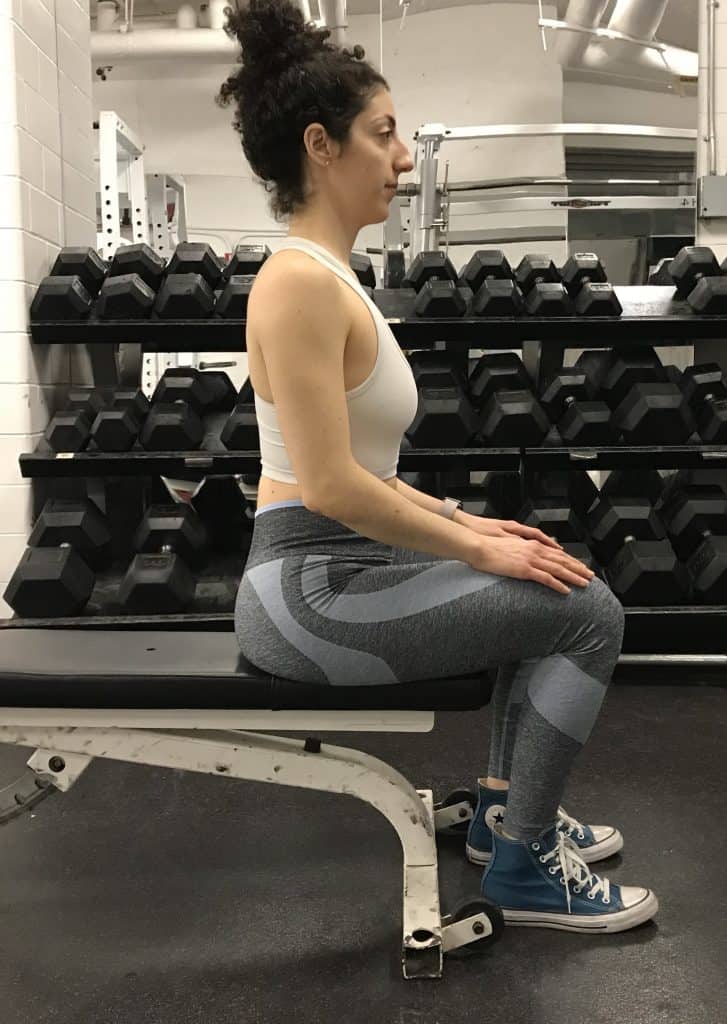
When sitting down, it is important to ensure that
- Your head is in a neutral position. Adjust your book/computer/workstation to a height so that you are looking straight ahead and not having to overly extend your neck
- Your ears should be aligned with the middle of your shoulder joint
- Your shoulders should be in the middle of their socket and not overly protracted in front of you
- Your upper and lower back should be in a neutral position. Your kyphotic and lordotic curves should have a slight physiologic curve
- For your lower body, just ensure that your weight is evenly distributed between your two hips and your feet.
Obviously, these explanations are examples of perfect posture.
It is not possible to be in a perfect position at all times. We must all move around and fidget, whether we are standing or sitting.
The important thing is to try your best and get back to a good neutral position as often as possible.
Ok, so here is where things go wrong.
But first…
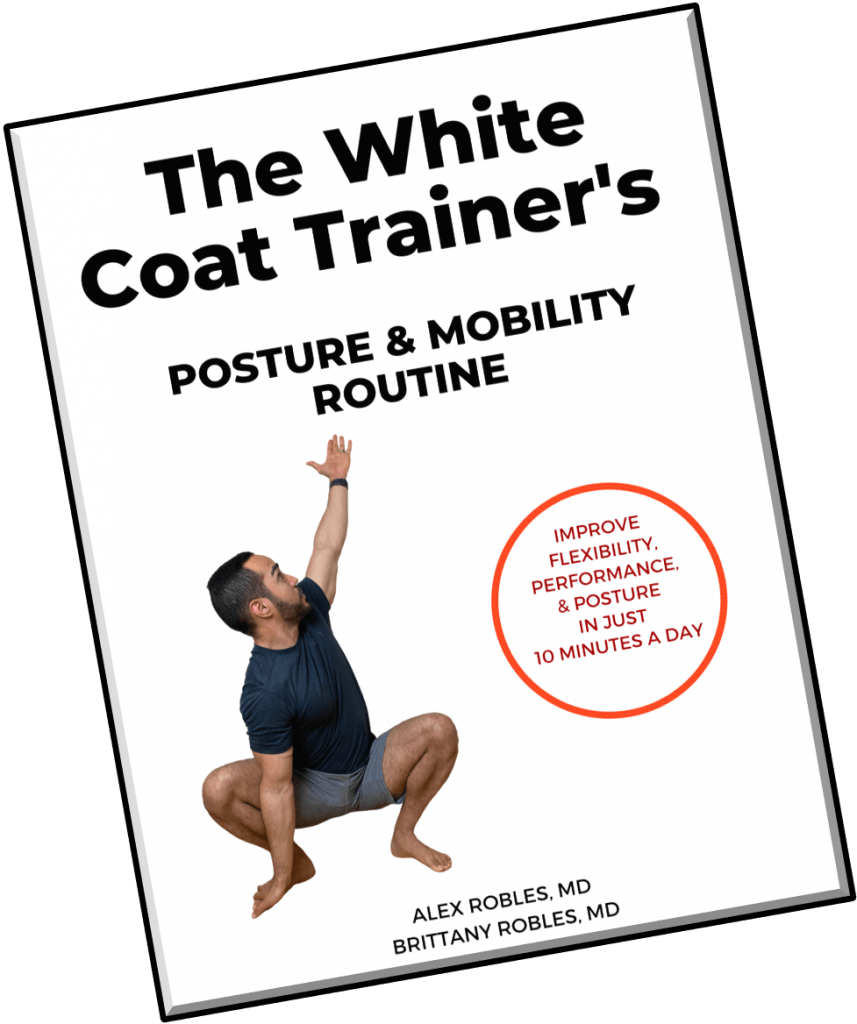
For just $7, you can get a complete summary of this entire blog post PLUS our complete 10-minute posture and mobility routine.
This routine combines high-yield exercises and stretches for both the upper and lower body to target the muscle groups most people need to work on.
Grab yourself a copy today!
Okay now, let’s go over examples of bad posture.
What Does Bad Posture Look Like?
Okay, so now let’s go over the four most common bad postures.
Bad Posture #1: Forward Head Posture
Forward head posture is exactly what it sounds like.
It refers to the position where your ears do not line up with your shoulders when looking at a side profile.
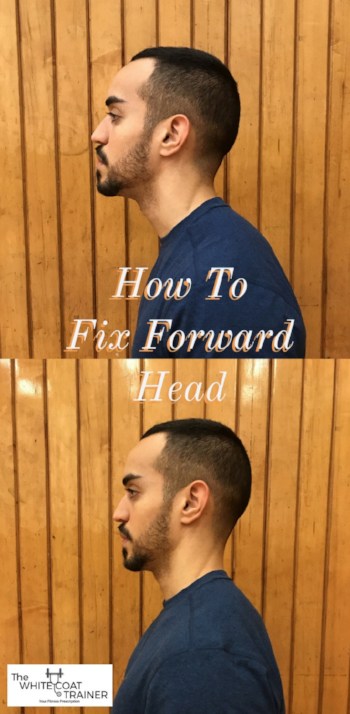
The forward head is due to an imbalance of your neck muscles and is often seen with the next bad posture, rounded shoulders.
It is also due to not being aware of your neck position when looking at a screen, commonly seen in office workers (aka tech neck).
When your head is not in line with your shoulders, your neck has to assume a compromised extended position just so that you can see what is in front of you.
In order to compensate and look straight ahead, your chin will have to poke out, and you will flex the muscles in the back of your neck (which extends your head).
Forward Head Posture Pain Symptoms
Forward head posture places a lot of strain on your cervical spine and the muscles of the posterior neck.
As a result, this posture can lead to neck pain, upper back pain, and tension headaches.
How To Tell if You Have Forward Head Posture
- If you have pain in the back of your neck, you probably have forward head posture.
- If you cannot bring your chin to touch your chest while your teeth are clenched- you probably have forward head posture.
- If the back of your neck isn’t straight when looking from the side- you definitely have forward head posture
Bad Posture #2: Rounded Thoracic Spine (Kyphosis)
Out of all the postural inefficiencies – rounded thoracic spine is probably the most prevalent.
This is because of our sedentary culture that cherishes sitting the majority of the day.
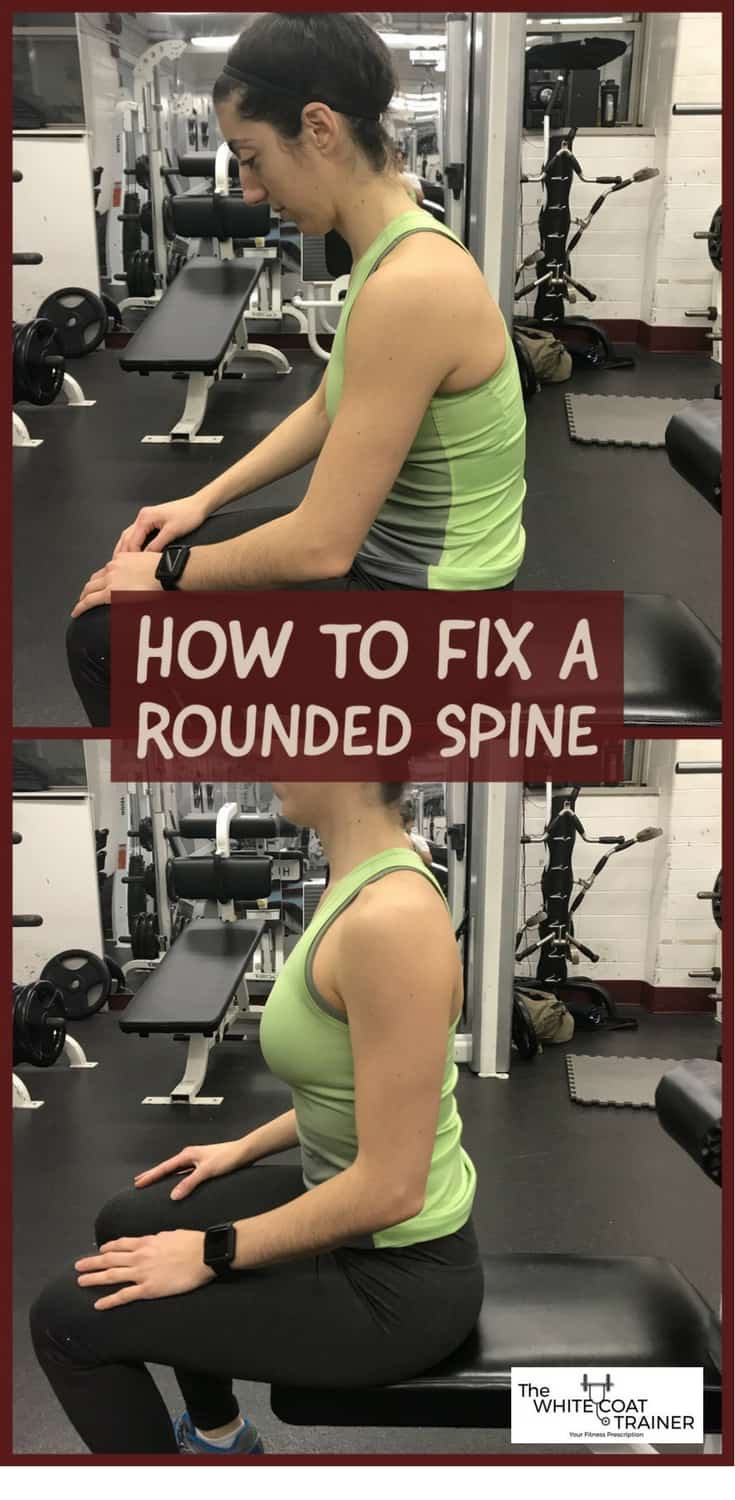
When you sit, you tend to relax a lot of the muscles that would normally be activated when you are standing or moving around.
This includes the abdominal muscles as well as the spinal erectors which run vertically along either side of our spine.
When you sit for long periods of time, your upper back muscles and shoulder blades will become inactivated and lengthened.
The end result is slouching.
If you’re not careful, you can slouch for several hours a day, every day of the week.
The more time your body remains in a certain position, the more likely it will begin to adopt that position as its new norm.
A rounded thoracic spine can result in multiple other postural inefficiencies – forward head posture decreased shoulder range of motion and tightening of the muscles in your anterior thorax.
Furthermore, the muscles of your upper back become weak from a lack of use.
Kyphosis Pain Symptoms
A Kyphotic posture leads to pain and stiffness in the upper back and a tendency to strain your anterior shoulders and chest muscles.
In addition, the pronounced curve in the thoracic spine can cause unnecessary wear and tear to your lordotic curve also resulting in lower back pain.
How To Tell If You Have A Rounded Thoracic Spine
- Stand up and have someone take a picture of you directly from the side. (Make sure to not overly compensate your posture, and stand as you would normally). If the middle of your shoulder joint does not line up with the middle of your hip joint vertically, then your probably have a rounded spine.
- If your kyphotic curve simply looks very pronounced, then you have a rounded thoracic spine.
The Wall Test
- Stand up against a wall with your feet six inches away from the wall. Can you make three points of contact with your head, upper back, and butt without pushing your head back? If you cannot, you probably have a rounded thoracic spine (as well as forward head posture).
Bad Posture #3: Rounded (Internally Rotated) Shoulders
Internally rotated shoulders can occur independently or in conjunction with a rounded thoracic spine.
In normal anatomy, the shoulder joint should sit in the center of the shoulder socket with equal and opposite forces tugging on it from both anteriorly and posteriorly.
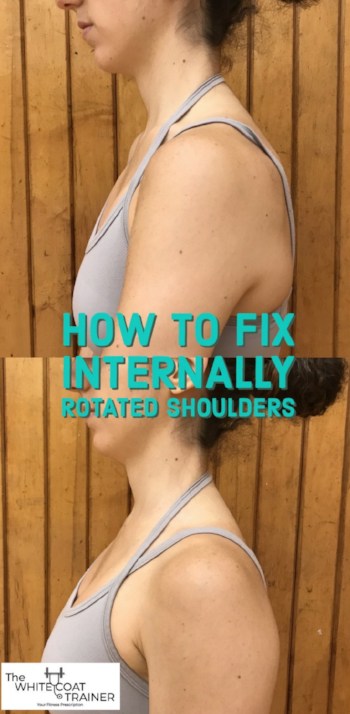
However, we always focus on our anterior side, or what is in front of us.
Think about how many times your arms are out in front of your body; typing on a computer, writing, cooking, cleaning, or pushing objects.
How often do you perform the opposite task? Tasks that bring your shoulder towards your back, aka pulling movements?
If you’re like most people – the answer is never.
Therefore, the anterior muscles and tendons become significantly stronger (aka they tighten and shorten) than the posterior muscles and tendons.
As a result, your anterior muscles pull the shoulder joint forward in the socket, rotating them in towards the midline (internal rotation).
Rounded Shoulder Pain Symptoms
The rounded shoulder posture deviates your shoulder joints forward out of their sockets.
As a result, this can cause pain in the front of your shoulders, especially when bringing your arms overhead or when you perform exercises such as pushups, bench presses, or even pull-ups.
How To Tell If You Have Internally Rotated Shoulders
- Stand up and grab two pencils. Hold them perpendicularly in your clenched hands so that the lead tips are facing away in front of you. Now, look at the pencils. Which way are they pointing? If they are angled towards each other- you have internally rotated shoulders.
- Take a picture of your side profile. If you cannot draw a straight vertical line from the back of your ear to the middle of your shoulder joint, you have internally rotated shoulders.
Bad Posture #4:Anterior Pelvic Tilt (Lordosis)
Do you have low back pain? According to the NIH, so do 80% of adults.
Low back pain is extremely complex and can have many different etiologies. Many people have dedicated their lives to the diagnosis and treatment of low back pain.
Anterior pelvic tilt, aka lordosis, is one of the more common causes of low back pain in young adults. Again, too much sitting is usually the culprit.
This posture is highly prevalent in tall, thin runway models.
It’s also prevalent in individuals who try to puff out their butt to make it look bigger.
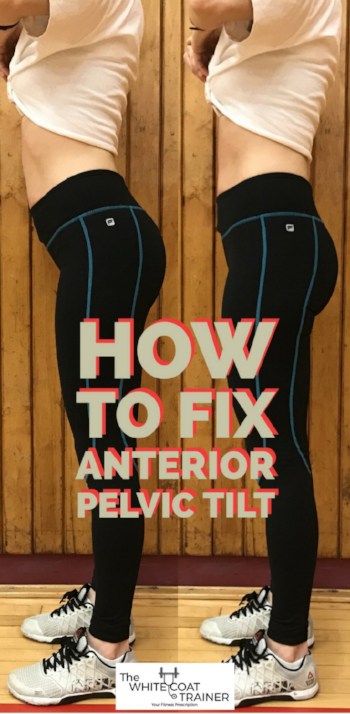
When you sit, your hip flexors (the muscles that bring your thighs towards your chest) are in constant flexion and your core muscles are turned off.
Tight, short hip flexors will pull on the pelvis from the front, creating an anterior tilt and exaggerating your lordotic spinal curve.
Furthermore, the muscles on the posterior side of the pelvis, namely the glutes and the hamstrings will become elongated and inactivated by a lack of use.
Anterior pelvic tilt was the biggest cause of my low back pain when I first started learning about posture and pain.
Anterior Pelvic Tilt Pain Symptoms
The Anterior Pelvic Tilt rotates your pelvis forward putting excessive strain on the muscles of your lower back. Therefore, this posture will result in low back pain sooner or later, as well as an increased risk of disc bulge and herniation.
It can also lead to discomfort in the anterior hip, as these muscles are extremely tight and over activated.
How To Tell If You Have Anterior Pelvic Tilt
- Lay on the floor on your back, and bend your knees. From this position squeeze your glutes as hard as you can until your hips are extended and you create a Glute Bridge.
- Are you able to draw a straight line from your knees down to your shoulders? Or are you broken at the hips? If you are broken at the hips and cannot achieve a full hip extension, then you probably have lordosis from tight hip flexors.
- Look at a side profile photo of yourself. Is there an exaggerated lordotic curve in your lower back and a bellowing out of your belly These are also indications that you have excessive anterior pelvic tilt.
Other Related Questions
What is bad posture?
Bad posture is when your joints are in suboptimal and unnatural positions due to muscular imbalances and poor body awareness.
As a result, this creates muscle tension in some areas, and weak and stretched muscles in other areas.
What causes bad posture?
Bad posture is caused by muscular imbalances that are created from poor bodily positions in our daily activities AND from repetitive unnatural movements patterns.
These include:
- Sitting for several hours a day,
- Typing on keyboards way out in front of us
- Holding cell phones to our heads with our shoulder shrugged up
- Keeping your head focused on a computer screen
The problem is, we do these activities for numerous hours every single day and we don’t do enough of the activities we were meant to do.
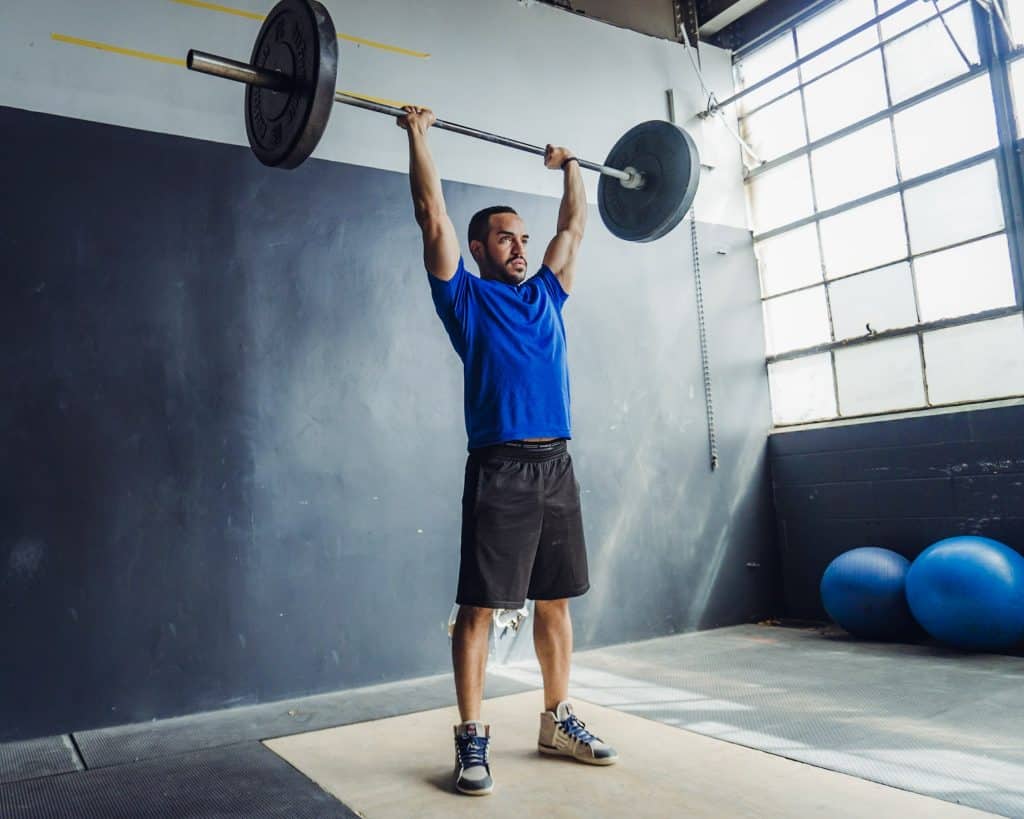
Unless you are born with congenital musculoskeletal problems, all of your muscles should be limber and you should have adequate range of motion in all of your major joints.
In other words, we are born with good posture, and acquire bad posture after years of putting our bodies in inefficient positions.
What are the typical bad posture symptoms?
Bad posture is something that far too many people don’t pay attention to.
The manner in which you sit, stand, and move can have a profound impact on your life- much larger than you’d expect.
Here are the 4 worst symptoms that poor posture can cause.
1) Poor Posture Effect #1: Nagging Pain
Do you have nagging pain anywhere? Your neck, shoulder, knee, or back?
Your body is meant to function as one integral unit.
Bad posture in one joint will result in significant muscle strain at nearby joints.
This happens because nearby joints will have to pick up more slack than usual and develop excessive wear and tear.
Your body is only as strong as its weakest link.
2) Poor Posture Effect #2: Movement Restriction
Your body is meant to exhibit a broad range of natural movements.
You should be able to squat all the way down, reach completely straight overhead, and perform a bunch of other natural movements without any restriction.
Be sure to check out our article on How Flexible Are You to see how you match up to the ideal standard.
Unfortunately, bad posture can cause your joints to become tight, stiff, and painful, ultimately robbing them of their mobility.
Most kids are born with their full range of motion.
This is me exhibiting a perfect full range of motion squat at the age of 5.

Even as an adult, you should still be able to perform several basic functional movements.
This is especially true for an athlete of any kind. Whether you decide to lift weights, play basketball or be a dancer, you must be able to get into certain positions to accomplish your sport efficiently.
Any movement restriction has the potential to cause a preventable injury during your athletic activity.
Getting older is not an excuse to let your joints and your movement patterns deteriorate. This is preventable. It starts with fixing your posture.
3) Poor Posture Effect #3: Breathing Difficulty
Believe it or not, bad posture can impair this process by creating a restrictive lung pattern.
This means your posture can put your lungs in a compromised position, and make them unable to expand to their normal capacity.
In essence, people with a bad posture are impairing their ability to expand their lungs to full capacity. This is happening 14-16x a minute!
Less oxygen means less mental clarity, fewer nutrients to your muscles, and less overall energy.
4) Poor Posture Effect #4: Poor Body Language
There is some research suggesting that bad posture and mental health are related. Individuals who are depressed and more likely to sit with slumped shoulders.
In one study, participants with mild to moderate depressions were taught how to sit with improved posture and were then asked to give a speech. The researchers noted more energy, less self-focus, and improved mood.
You do not have to walk around with your chest puffed out, but you should be cognizant of your body position throughout the day.
Do your best to keep your spine and shoulders in a healthy position.
It can say a lot about you.
How can I check my own posture?
You can check your own posture by taking a side picture of yourself standing in your typical posture. Do your best to take the picture perfectly from the side to get the best information.
Next, go through this checklist:
- Is my head is in a neutral position where my ear is lined up with the middle of my shoulder joint?
- Is the middle of my shoulder joint in line with the ear?
- Are my upper and lower back in a neutral position with a natural curves? (slight curves are normal)
- Is the middle of my hip in line with the middle of my shoulder above… and the middle of my knee joint below ?
- Is the middle of my knee is in line with the middle of my ankle?
Is bad posture permanent? Can you correct years of bad posture?
Bad posture is not permanent, but it is harder to reverse the longer you’ve had it. The most important thing is to be aware of the body positions you are in throughout the day.
Even with regular posture and mobility work, you will undo your efforts if you continue to sit and stand with bad postures.
How Do You Fix Bad Posture?
The first step to fixing bad posture is identifying which of the four bad posture symptoms you exhibit. Then you have to avoid putting your body in these positions throughout the day while engaging in a mobility routine to reverse these muscular imbalances.
We go over the best posture correction exercises in this post, or you can get a copy of my 10-minute mobility guide if you are short on time!
Final Thoughts On How To Know If You Have Bad Posture
So as you can see, ignoring your posture can lead to many undesirable complications.
The good news is, many of these things are preventable and treatable.
Improving your posture will
- Make you look taller,
- Make you appear more confident,
- Elevate your mood,
- Improve your circulation,
- Improve your breathing
- Align your muscles and joints in the most efficient orientation
- Decrease your risk of aches, soreness, and injury
All it takes is a small amount of postural education and breaking bad habits.
Related Posts On Bad Posture
- The Best Posture Correction Exercises To Fix Your Body Quickly
- The Best Stretches To Increase Flexibility Fast
- The 17 Best Ab Exercises To Help Improve Posture
Now we turn it over to you.
How many of these abnormal postures do you have?
Have you noticed any friends or family members with these positions?
Do you know of any other positions we could add to this list?
Comment below and let us know!

Alex Robles, MD, CPT / Brittany Robles, MD, MPH, CPT
Alex & Brittany Robles are physicians, NASM Certified Personal Trainers, and founders of The White Coat Trainer: a resource dedicated to improving the health and fitness of busy professionals using time-efficient strategies. Their advice has been featured in My Fitness Pal, Prevention, Livestrong, Reader’s Digest, Bustle, The Active Times, and more. Learn more about them here.

I have every one of these bad posture issues but mine come from not sitting but standing all day as a hairdresser. I’m twisting and turning my back and looking down at people’s heads as well as constantly having to lean forward over people because THEY won’t sit straight even after I’ve asked them a million times to straighten up!!! My shoulders roll forward, my neck is always hurting i have chronic pain in between my shoulder blades, my hips hurt, my ankles ache and let’s not get into my feet and the years of pain I have had. I suffer from muscle cramps in my hips and sides no matter how much water I drink. I really hope these exercises help me!!!
Hi Mary
Sorry to hear this, but it sounds like you have figured out the source pretty well. Definitely give the exercises a try as well as the posture resets shown in the videos!